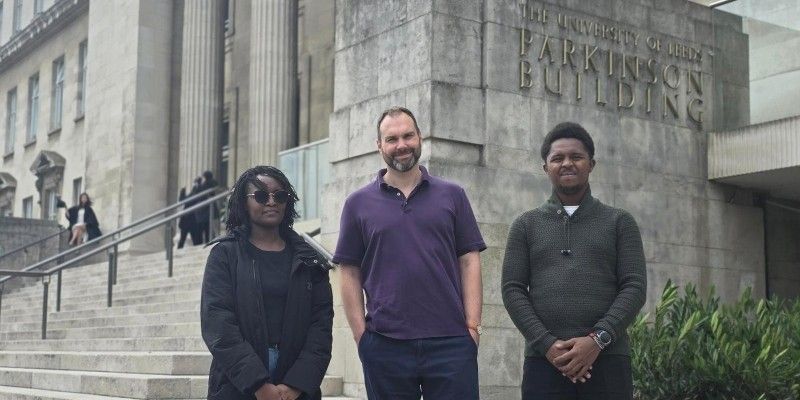Kenyan students have demonstrated how Artificial Intelligence can enhance the study of endangered animals.
Yuri Njathi and Lorna Mugambi from Dedan Kimathi University of Technology in Kenya, presented their research findings to AI and ecology experts at the University of Leeds, illustrating how knowledge can be shared across borders to make a difference in the world.
Yuri and Lorna's work looked at the development and use of camera traps, which provide valuable wildlife data that could answer questions about animal species, population sizes and animal interactions. The two students have used machine learning-based methods to explore camera trapping data at scale.
The animals captured in these images include zebras, hyenas, lions, ostrich, warthogs, elephants, aardvarks and cheetahs. The work showcased evolved around the need to detect the endangered Grévy's zebra and to estimate its relative population. 90% of Grévy's zebras are thought to be present in Kenya.
They previously presented their research at an AI in ecology workshop at Deep Learning Indaba X Uganda last year.
Presenting our research at the conference was pivotal. Without the work we put in and the platform that conference provided, this visit simply wouldn't have happened.
Yuri Njathi, who is studying his MSc in Electrical and Electronics Engineering, said: "The beauty of the visit was that it will enable students who have skills in applied AI, like us, and experts in ecology to work together. This will ultimately enable quicker answering of ecological questions and working towards goals more efficiently."
"The visit has connected us to more researchers and ecologists who have a strong background in Zoology which is the kind of collaboration we would love to be involved with.
"After the presentation we received questions about how we can integrate this system with work in crayfish detection. We also met with a postdoc from Ethiopia based at the University of Leeds working on bioacoustics and camera trapping in the Omo River valley (on the border with Kenya) where other Grévy's zebras are expected to be present. This opportunity has been fantastic for providing us with the kinds of connections that can be mutually beneficial for the future."
The duo's AI analysis ensures more accuracy and speed by analysing up to 30,000 camera trap images to quickly identify which image holds the answer to research questions. The images found that for one Grévy's zebra, there were typically three Plain zebras at that conservancy. These findings are encouraging for the students and would lead to deployments over a longer period to analyse more data and to integrate their models with the systems at the conservancy.
The images the students have captured are in partnership with the Dedan Kimathi University Wildlife Conservancy next to the Dedan Kimathi University of Technology as well as the Mugie Wildlife Conservancy. They also spoke about work on monitoring insects by analysing images, a partnership between their centre, the Centre for Data Science and Artificial Intelligence and the UK Centre for Ecology & Hydrology.
Lorna, who has completed her MSc in Telecommunication Engineering, explained that the fantastic opportunity began at the Deep Learning Indaba X Uganda conference in 2024, where the Leeds Africa Hub for Data Science and Artificial Intelligence sponsored their attendance.
She said: "Presenting our research at the conference was pivotal. Without the work we put in and the platform that conference provided, this visit simply wouldn't have happened.
"It's been incredibly beneficial to talk through the problems we all face, particularly in the ecology field. Despite working with different species – from our mammalian focus to their deer and crayfish research – many of the challenges with camera trap data proved to be remarkably similar.
"We even found that some of our solutions could be readily applied to their datasets, like those for crayfish, bridging a significant gap in our shared work.
"I've really enjoyed this visit and meeting with Professor Richard Mann and the ecologists at the University of Leeds."

Richard Mann, Professor of Mathematical Ecology and Evolution at the University, said: "It has been a real pleasure to host Lorna and Yuri in Leeds, where they have showcased their research in applying Data Science and AI to a range of disciplines.
"Lorna and Yuri are great examples of the exciting work that is being done in Data Science and AI across Africa, and especially the potential of early career researchers to contribute to their own societies and also to the global development of Data Science and AI research."
Yuri and Lorna were given the opportunity through the Leeds Africa Hub for Data Science and Artificial Intelligence which has enabled them to connect with different researchers from different places. During their time in the UK, the two students also visited Swansea University and gave a similar presentation to ecologists.






